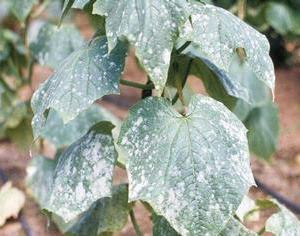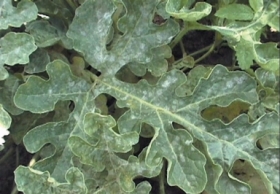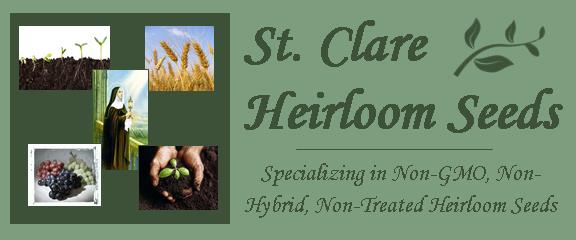Powdery mildew is one of the most easily recognized Heirloom / Open Pollinated Vegetable Garden plant diseases and also one of the most common. Squash and cucumbers are all likely targets for powdery mildew.

Every year about midsummer, we start getting questions from people wanting to know what those white or gray powdery spots are on their Heirloom / Open Pollinated Vegetable Garden plants. They often cover most if not the entire leaf surface, plant stems, flowers and even fruit. Powdery mildew is a fungus that forms as a white or gray powder on the leaves of vegetable plants causing the leaves to become deformed and die. Powdery mildew can be a real problem in the Heirloom / Open Pollinated Vegetable Garden, especially for cucurbits such as cucumbers, squash, melons and pumpkins. It is far more of a problem in areas that are damp, or somewhat shady, and have higher levels of humidity. It can also be a problem when your area gets an usually long rain spell and the Vegetable Garden plants don’t dry out for weeks.
Powdery Mildew looks like talcum powder, on the leaves and stems of plants. There are actually several types of powdery mildew fungi, but they all look basically the same. You may not notice a problem until the top surfaces of the leaves turn powdery, but powdery mildew can also affect the lower leaf surface, stems, flowers, buds and even the fruit. Vines may also wither and become whitish. It is difficult to control powdery mildew once it begins spreading on the vegetable plant leaves.  In advanced stages, however, powdery mildew can cause foliage to yellow, curl or turn brown, and eventually defoliate the plant prematurely. On flowering plants and trees, the fungus can lead to early bud drop or reduced flower quality.
In advanced stages, however, powdery mildew can cause foliage to yellow, curl or turn brown, and eventually defoliate the plant prematurely. On flowering plants and trees, the fungus can lead to early bud drop or reduced flower quality.
Causes and prevention of powdery mildew on Heirloom / Open Pollinated Vegetable Garden Plants
Conditions that favor mildew formation include wet foliage, high humidity, low light and moderate temperatures. These conditions cause the vegetable garden plants to never dry out, creating the perfect environment for the powdery mildew fungi. Pro active steps to avoid or minimize this risk include:
- Buy disease-resistant Heirloom / Open Pollinated varieties.
- Provide adequate air circulation by not crowding plants.
- Plant your garden plants where they will get sufficient light.
- Avoid over-fertilization. Leaves are more susceptible within 2 to 3½ weeks of unfolding.

Controlling an existing problem
Early detection provides the best way to contain and potentially eliminate the problem. Most conventional, off-the-shelf products are made for prevention and control, not elimination of an existing infection. One of the most common multipurpose fungicides for control contains the active ingredient chlorothalonil. Daconil 2787 is probably the most well-known brand containing this ingredient. Although effective, it coats the leaf surface with a white, milky film that is quite noticeable.
Other lesser known remedies
- Neem oil – This is an organic disease control that doubles as a natural insecticide that is kinder to beneficial insects and mammals than many other options.
- Baking soda – This is the best known of the homemade solutions. Although studies indicate that baking soda alone is not all that effective, when combined with horticultural-grade or dormant oil and liquid soap, efficacy is very good if applied in the early stages or before an outbreak occurs. Mix 1 tablespoon of baking soda with 1 teaspoon of dormant oil and 1 teaspoon of insecticidal or liquid soap (not detergent) to 1 gallon of water. Spray on plants every one to two weeks.
- Potassium bicarbonate – Similar to baking soda, it is a contact fungicide, which kills the powdery mildew, eliminating the disease once it’s there. In addition, it’s approved for use in organic growing.
- Mouthwash – Generic, ethanol-based mouthwash can be very effective. Use one part mouthwash to three parts water; just be careful when mixing and applying mouthwash, as new foliage can be damaged.
- Vinegar – The acetic acid of vinegar can control powdery mildew. A mixture of 2 to 3 tablespoons of common apple cider vinegar, mixed with 1 gallon of water, does the job — but concentrations of acetic acid above 5 percent are more effective. However, use with caution. It is commonly used as a natural herbicide and too much vinegar can burn plants.
- Milk – It is believed that naturally occurring compounds in milk work to combat the disease while also boosting the plant’s immune system. One experiment showed good results by applying a weekly dose of one part milk to nine parts water. Concentrations above three parts water had adverse side effects.

